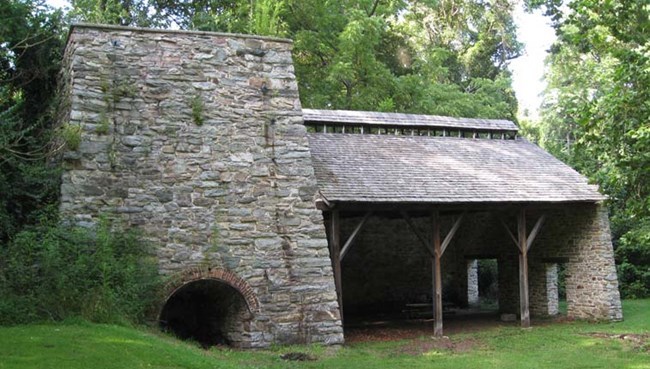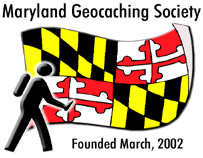The 2021 version of the HCWHA Geotrail has been mostly archived as of August 2025. This cache is no longer part of the official Geotrail, but I've kept the original text for historical information. A new HCWHA Geotrail will be publishing in September 2025.
The Heart of the Civil War Heritage Area Geotrail
Catoctin Furnace

You're invited to take a journey through the Maryland's Heart of the Civil War.
The Heart of the Civil War Heritage Area Geotrail was first launched in the fall of 2016 with geocaches hidden within Maryland's Carroll, Frederick, and Washington Counties. In the spring of 2021, the Geotrail was updated with five additional geocaches and an Adventure Lab.
The Heart of the Civil War Heritage Area (HCWHA) is an area rich in history, covering portions of Maryland’s Carroll, Frederick and Washington Counties. It is located just below the Mason-Dixon Line, generally viewed as the dividing line between North and South, and above the Potomac River. With one foot in the north, and one foot in the south, the story of the Civil War can be told nowhere better than in this part of Maryland.
Between 1861 and 1865, the Civil War impacted every Maryland resident, many directly as a result of the war that was waged within the state’s borders. Some families faced financial ruin after troops ravaged their land. Thousands of fathers, sons and brothers became casualties of war. For enslaved Marylanders, the conflict ultimately brought about freedom as the new state constitution of November 1864 abolished slavery.
This region witnessed three major military movements during the Civil War: the Maryland (also known as Antietam) Campaign in the fall of 1862, the Gettysburg Campaign in the summer of 1863, and the march to Washington led by Jubal Early in the summer of 1864.Geocachers can visit significant sites from each of these three operations on the Heart of the Civil War GeoTrail.
The mission of the Heart of the Civil War Heritage Area is to promote the stewardship of our historic, cultural, and natural Civil War resources; encourage superior visitor experiences; and stimulate tourism, economic prosperity, and educational development, thereby improving the quality of life in our community for the benefit of both residents and visitors.
Geocachers who find the locations of at least 13 HCWHA caches are eligible for a free prize and may purchase a Geocoin (while supplies last of both). To record and redeem the finds, Geocachers must download a passport from the Heart of the Civil War website and record the code word from at least 13 HCWHA geocaches. Geocachers may have their passports validated in person at the Newcomer House at Antietam National Battlefield or at the Visitor Centers in Westminster or Frederick. See the Heart of the Civil War Heritage Area’s websitefor details on Geocoin and free prize availability.
Participating in the HCWHA geotrail is fun and we hope that many people join in. However, it is not a requirement for logging your find on this cache once you find the container.

The historic furnace stack before you, known as “Isabella,” was constructed before the Civil War. Built in 1857, it’s the survivor of an iron-making industry that was in operation here from 1776 to 1903.
The historic Catoctin Furnace represents, in microcosm, the history of the Industrial Revolution in America. From 1776 to 1903 iron companies mined the rich ore banks near Catoctin Mountain, smelted it in furnaces, and cast both raw pig iron and iron implements of every description. In blast by 1776, the furnace produced ammunition for the Continental Army including shells fired during the siege of Yorktown. Following independence, owner Thomas Johnson became Maryland’s first governor. The furnace site grew into a village complex with a concentration of specialized workers. A charcoal house, casting house, foundry, forge, stables, wagon sheds, saw mill, store, and church were all necessary to the iron operation, not to mention housing for miners, colliers, furnace fillers, founders, forge men, foremen, blacksmiths and other skilled workers.
Enslaved Africans provided a large part of the labor force at Catoctin Furnace in the early days. It was common for enslaved African laborers to be used in iron manufacture in the mid-Atlantic. The roles as well as the first (and only) anglicized name of some enslaved individuals at Catoctin Furnace are clearly stated in the 1809 will of Baker Johnson. Johnson enslaved more than 80 people including men such as Collier Sam and Waggoners Henry and Harvey. Highly skilled and experienced, these enslaved craftsmen worked as blacksmiths, colliers, founders, and forge men. In addition to their roles in the making of iron, members of the enslaved community toiled in the vineyard and at other agrarian tasks on large farms surrounding the furnace. They also worked as domestic servants for the ironmasters and their families.
By the middle of the 19th century, the number of enslaved workers at Catoctin declined sharply as large numbers of European immigrant workers moved into the area. Hiring European immigrant labor was cheaper than keeping a large enslaved population to work at the furnace. Throughout the 19th century, periods of instability, changes and modernization characterized the industry at Catoctin Furnace. In 1857, “Isabella,” a sophisticated new furnace powered by steam-operated machinery and a 33-foot-high furnace stack was added to the complex. “Isabella” was in continuous blast until 1893 and is still standing today. In 1873 a third stack was built about 140 feet south of “Isabella”. Named “Deborah,” this new stack was a steam- and water powered, coal fired furnace. In 1903 Catoctin Furnace was forced to shut down due to its unprofitability.
Today, the stack known as “Isabella” is the focal point of the Catoctin Furnace remains. The 1858 casting shed has been reconstructed next to it. Just south of the furnace are stone and log houses originally occupied by company workers. An interpretive trail connects the furnace area to an overlook near the African American cemetery. The Collier’s Log House, Forgeman’s House, and Museum of the Ironworker have been restored by the Catoctin Furnace Historical Society, Inc. During archaeological excavations at the Forgeman’s House, a concentration of Civil War era artifacts was recovered. The assemblage was most likely of Union use and manufacture, with the possible exception of a two-groove .58 caliber Minie ball. Learn more about Catoctin Furnace history, activities, and special events at www.catoctinfurnace.org or by calling 240-288-7396.
There is limited parking at the museum where the cache is located. There is also additional parking at the furnace where you can take a trail to the back of the museum area. The distance to the museum is fairly short using this trail. Either side of the museum is private property. Please stay on the museum property. The hint should get you to the cache. This cache has been approved by the Maryland DNR.
 Thanks to the following members of the Maryland Geocaching Society in placing the hides for this Geotrail Refresh: deepdish23, hunterKat, lpyankeefan, and tazscouter.
Thanks to the following members of the Maryland Geocaching Society in placing the hides for this Geotrail Refresh: deepdish23, hunterKat, lpyankeefan, and tazscouter.